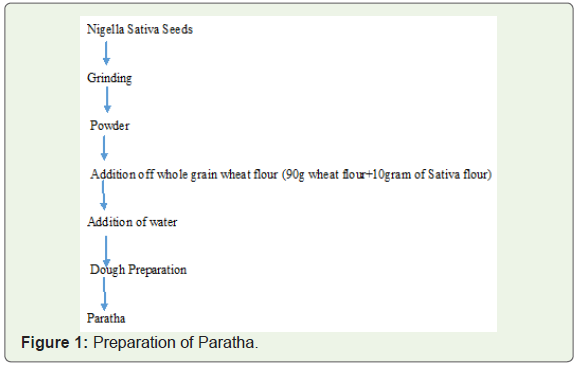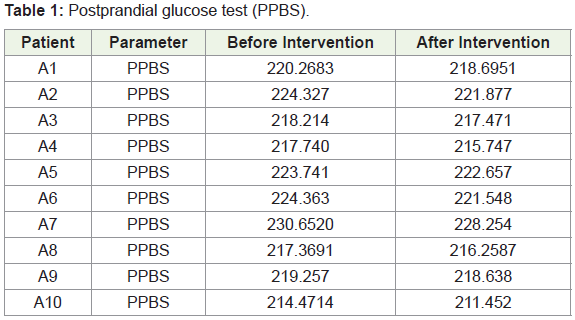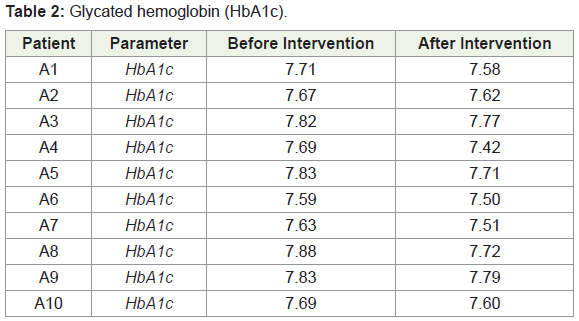Research Article
Effect of Kalonji (N. sativa) Paratha (flat bread) Diet on Glycemic Control of Patients with Type-2 Diabetes
Quadri Mohd shajiuddin* and Siddiqui Furquan YJ
RIMT University, India
Corresponding author: Quadri Mohd shajiuddin, PhD Scholar, RIMT University, Mandi Gobingarh, Punjab, India, E-mail: quadri.shaji@rediffmail.com
Citation: Quadri Mohd shajiuddin, Siddiqui Furquan YJ. Effect of Kalonji (N. sativa) Paratha (flat bread) Diet on Glycemic Control of Patients with Type-2 Diabetes. Indian J Nutri. 2018;5(2): 189.
Copyright © 2018 Quadri Mohd shajiuddin, et al. This is an open access article distributed under the Creative Commons Attribution License, which permits unrestricted use, distribution, and reproduction in any medium, provided the original work is properly cited.
Indian Journal of Nutrition | ISSN: 2395-2326 | Volume: 5, Issue: 2
Submission: 20/06/2018; Accepted: 17/07/2018; Published: 19/07/2018
Abstract
Nigella sativa (N. sativa) has been used in traditional medicine and many studies have been performed in different communities in order to reveal the effects of it on medical disorders and chronic diseases. The aim of this study was to investigate the effects of Paratha Diet with N. sativa on postprandial glucose, Glycated hemoglobin, and Triglycerides. A randomized, double-blind, cross-over and clinical trial was conducted on 10 patients of both sexes with age group of 20-50 years old in City Of Jeddah, Kingdom of Saudi Arabia. In this study, treatment, sequence and time effects of intervention were evaluated and revealed that consumption of bread with N. sativa has significant treatment and time effects on postprandial glucose, Glycated hemoglobin.
Keywords:
Nigella sativa; Diabetes-2; Glycemic control; Glycated hemoglobin (HbA1C); Postprandial Glucose Test (PPBS)
Introduction
Nigella sativa is a small plant originating in the Middle East and is found abundantly, growing wild in Egypt, Asiatic Turkey, and the Balkan states. N. sativa has tapering green leaves and rosaceous white, yellow, pink, pale blue or purplish flowers with 5-10 petals. The ripe fruit (capsule: 3-7 united follicles) contains numerous tiny seeds, dark black in color. The seed and oil of N. sativa was frequently used in ancient remedies (Unani, Ayurveda, Chinese and Arabic) in Asian countries and in the Middle-East [1]. The use of N. sativa seeds had been mentioned by Ibne-Sina (980–1037) in his famous book al-Qanun fit-Tibb [2]. Traditionally N. sativa is used as a medicament of a variety of disorders in the respiratory system, digestive tract, Cardiovascular System (CVS), kidney, liver, and immune system [3,4]. Its uses in fatigue and dispiritedness are antique. The most common traditional uses belong to the ailments, including asthma, bronchitis, rheumatism and related inflammatory diseases, indigestion, loss of appetite, diarrhea, dropsy, amenorrhea, dysmenorrhea, worms and skin eruptions. It is also used as antiseptic and local anesthetic [5-9].
Material and Methods
Study design A cross-over, double-blind, and randomized clinical trial was conducted in 10 type 2 diabetic patients of both sexes with age group of 20-65 years old in Jeddah, Kingdom of Saudi Arabia and the diet was supplied for a period of two months.
Preparation of paratha
The N. sativa (black seed) was purchased from a local market. After several grinding and screening of seeds, the powder of black seed was delivered to a local Paratha Maker in Jeddah City. Each Paratha include 10 gram of powder of black seed (Figure 1).
Results and Discussion
Among the 10 patients with type-2 Diabetes who were included in this study. Postprandial glucose test of patients are summarized in Table 1. Number of men and women were 05 and 05, respectively. Glycated hemoglobin of patients is represented in Table 2. Studies carried out as before and after the intervention of the diet [10-14].
Conclusion
Nigella sativa can be used as add on drug therapy in patients with poor glycemic control. Nigella sativa is safe and effective remedy. It is observed that it has ability to reduce the PPBs and Hb1Ac N. Sativa has the potential to be used as a natural adjuvant to oral glucose lowering drugs in the management of type 2 diabetes mellitus. As NS is a very low cost herb, therefore the potential cost benefit ratio will be in favor of benefit. Further clinical trials are recommended to move forward in this promising area of research.
References
- Gilani AH, Jabeen Q, Khan MAU (2004) A review of medicinal uses and pharmacological activities of Nigella sativa. Pak J Biol Sci 7: 441-451.
- Badary OA, Abdel-Naim AB, Abdel-Wahab MH, Hamada FM (2000) The influence of thymoquinone on doxorubicin-induced hyperlipidemic nephropathy in rats. Toxicology 143: 219-226.
- Al-Ghamdi MS (2001) The anti-inflammatory, analgesic and antipyretic activity of Nigella sativa. J Ethnopharmacol 76: 45-48.
- Al-Awadi F, Fatania H, Shamte U (1991) The effect of a plants mixture extract on liver gluconeogenesis in streptozotocin induced diabetic rats. Diabetes Res 18: 163-168.
- El Tahir KE, Ashour MM, al-Harbi MM (1993) The cardiovascular actions of the volatile oil of the Black Seed (Nigella sativa) in rats: Elucidation of the mechanism of action. Gen Pharmacol 24: 1123-1131.
- Zaoui A, Cherrah Y, Alaoui K, Mahassine N, Amarouch H, et al. (2002) Effects of Nigella sativa fixed oil on blood homeostasis in rat. J Ethnopharmacol 79: 23-26.
- Knowler WC, Barrett-Connor E, Fowler SE, Hamman RF, Lachin JM, et al. (2002) Reduction in the incidence of type 2 diabetes with lifestyle intervention or metformin. N Eng J Med 346: 393-403.
- Le PM, Benhaddou-Andaloussi A, Elimadi A, Settaf A, Cherrah Y, et al, (2004) The petroleum ether extract of Nigella sativa exerts lipid-lowering and insulin-sensitizing actions in the rat. J Ethnopharmacol 94: 251-259.
- Meral I, Yener Z, Kahraman T, Mert N (2001) Effect of Nigella sativa on glucose concentration, lipid peroxidation, anti-oxidant defense system and liver damage in experimentally-induced diabetic rabbits. J Vet Med A Physiol Pathol Clin Med 48: 593-599.
- Al-Awadi FM, Gumaa KA (1987) Studies on the activity of individual pants of an antidiabetic plant mixture. Acta Diabetol Lat 24: 37-41.
- Al-Hader A, Aqel M, Hasan Z (1993) Hypoglycemic effects of the volatile oil of Nigella sativa seeds. Int J Pharmacognosy 31: 96-100.
- El-Dakhakhny M, Mady N, Lembert N, Ammon HP (2002) The hypoglycemic effect of Nigella sativa oil is mediated by extrapancreatic actions. Planta Med 68: 465-466.
- Anas M, Mohsin M, Mannan A, Siddiqui M (2003) Hypoglycemic effect of Unani formulation (shunez karela khushk) on type-2 diabetes. Abstract book National symposium Emerging trends in Indian Medicinal Plants, pp: 83.
- Kanter M, Coskun O, Korkmaz A, Oter S (2004) Effects of Nigella sativa on oxidative stress and beta-cell damage in streptozotocin-induced diabetic rats. Anat Rec A Discov Mol Cell Evol Biol 279: 685-691.



